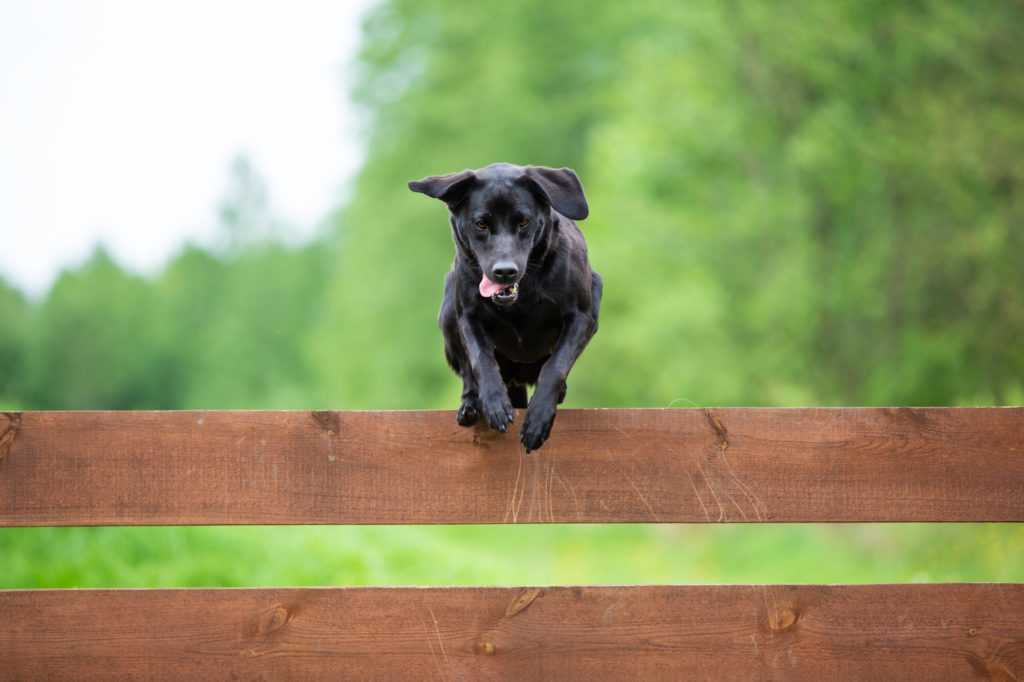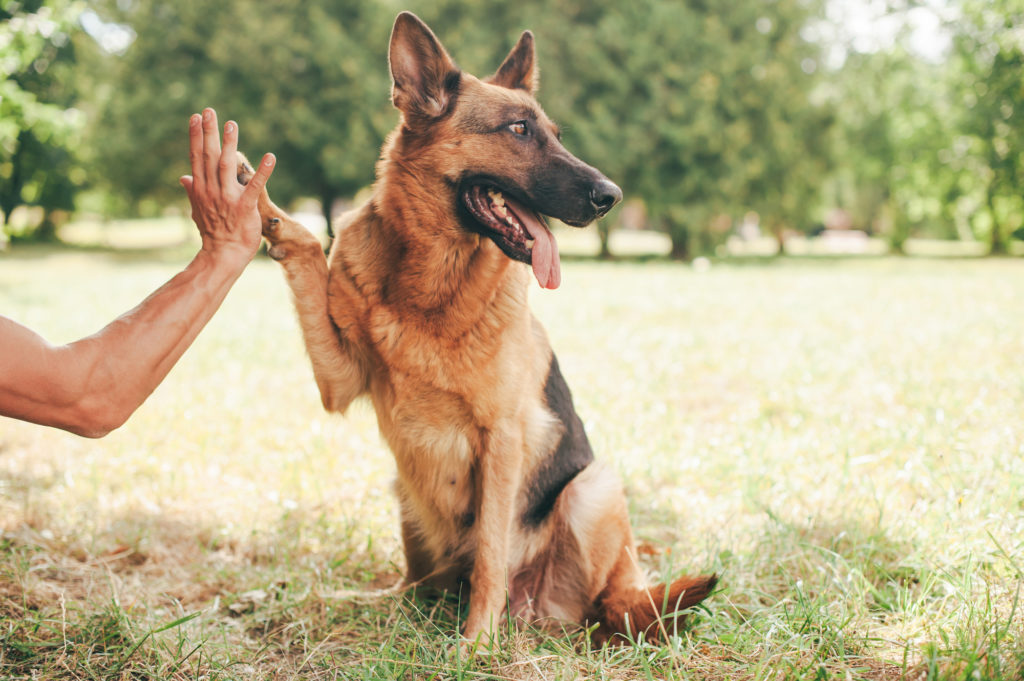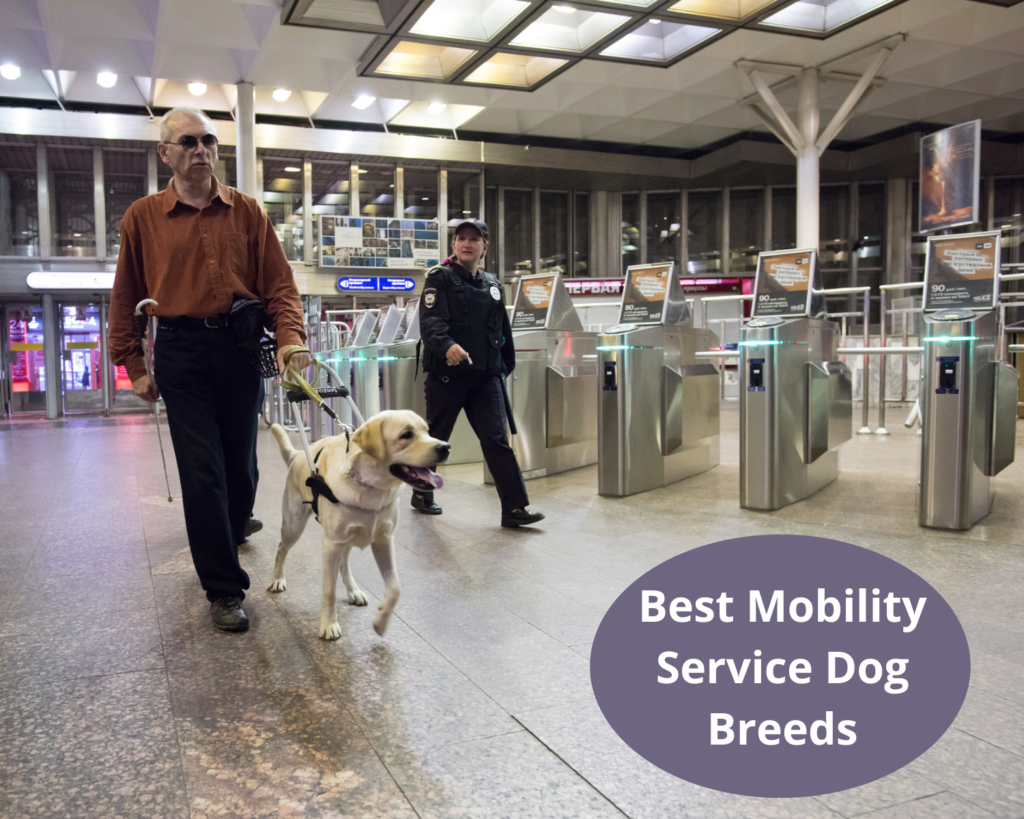Mobility service dogs can make a huge difference in the life of someone who needs them. But not all dog breeds are suited to the rigorous training and capabilities required.
Here are the best mobility service dog breeds, and everything you need to know about mobility service dogs.
Listing Of Breeds
- Labrador Retriever
- Newfoundland
- German Shepherd
- Bernese Mountain Dog
- Standard Poodle
What Is A Mobility Service Dog?
A mobility service dog is a dog trained to perform various tasks for a disabled human owner or partner. This allows their human partner to get things done that would be difficult or impossible for them to do alone, increasing independence from other people.
Mobility service dogs are specifically trained to assist those with physical disabilities that affect their movement. An individual with decreased mobility may struggle to open doors, retrieve items, move around, stand up unassisted, and more.
What Factors Make A Good Mobility Service Dog?
1. Size
The most important feature of a mobility service dog is its size. Dogs trained for this purpose will need to be able to support fully grown adults and pull wheelchairs, so they have to have sufficient strength for that task.
A dog typically needs to weigh at least 55 lbs and measure at least 22″ in height to be considered suitable, but this is merely a minimum.
Many individuals who need mobility assistance may also be overweight or simply heavier, in which case a dog will need to be even larger.
2. Frame
Mobility service dog breeds should have a bodily frame and structure suitable for supporting or pulling weight. This means they have little movement resistance while also maintaining high strength and work drive.
Typically, dogs with medium back lengths, even legs, balanced bone, and muscle composition, and square builds are best. The goal is a strong, highly balanced breed without limitation.
Even a small imbalance can cause a decrease in the effectiveness of mobility aid for an owner or worsened health for the dog.
3. Energy Levels
Athletic dogs make the best mobility service dogs because they’re able to perform multiple tiring and difficult tasks in a day, as their handler or owner needs.
Even very big dogs can sometimes have low energy, which would make them incompatible with most disabled people’s needs.
4. Grooming Needs
Good service dogs of any kind are typically quite low-maintenance when it comes to grooming. This is because disabled individuals may not have the energy or ability to groom a dog regularly or take care of excessive mess around their homes.
This is not true for all mobility service users, but it’s certainly a common factor.
As such, dogs who shed a lot of fur, need very regular baths, require daily or near-daily brushing, smell bad easily, and are prone to ear infections may not be the most suitable.
It is possible to send these dogs to a professional groomer, but that can be an expensive endeavor and its feasibility depends on the person.
5. Temperament
Good service dogs are not easily scared and aren’t prone to anxiety or aggression. They’re loyal and, while friendly in general, are primarily focused on their main owner or caregiver.
Dog breeds that are eager to please and are known to enjoy training and work tasks are better fits for a career in service work.
Of course, temperament tends to vary from dog to dog, so this depends on the individual dog and how well they perform in various tests and in training.
What Factors Do Not Make A Good Mobility Service Dog?
1. Extremely High Strength or Athleticism
It sounds surprising, but any extreme feature on a dog is a detriment to mobility services. Too much muscle, too-heavy bones, and too much energy all make for a poor service dog.
Dogs with very high energy levels and who need several hours of daily exercise might not be suitable for people who don’t need to be out and about very often.

This is because those who need mobility services are also likely to lack the energy necessary to thoroughly exercise a dog that wants to run for an hour! They are also likely to struggle to control a very strong or unusually heavy dog.
2. High Clinginess
Mobility service dogs often need to go to fetch items for their owners or may need to run and get help when necessary.
Dogs that are much too clingy will have trouble acting on their own and putting their training to good use when their owners are unable to directly command them.
3. High Independence
Not all dogs are equally trainable. Some are more independent and individualistic, making them more prone to disobedience or disinterest in learning.
While a service dog shouldn’t be a “velcro” dog who sticks to their owner like glue, they also shouldn’t be so independent that they can’t be trusted to follow orders.
A dog that prefers to go off and be on its own is not going to make a good dog for someone who could need it at any given moment!
4. Genetic Illnesses
Many service dogs are purebred breeds or close to purebred, which means they’re predisposed to a few genetic illnesses. That’s why selecting a candidate must be done cautiously, using a reputable certified breeder.
Breeders can perform health tests that ensure only good genes are carried forward to new puppies.
Mobility service dogs even more crucially need to be free from structural flaws and genetic illness. They can become ill or unable to work if their joints and bones are predisposed to degenerative disease.
Regular health testing will still be necessary throughout a dog’s life, but it’s best to start off on the right foot.
5. Any Factors That Make Training Difficult
When it comes to mobility service dogs and most service dogs, most expert trainers operate under the assumption that what they see is what they get.
While training is important, it’s best to start off with a dog that is the perfect candidate for training, to begin with. There’s no point in trying to “fix” something about a dog, as that creates an uphill battle.
What Reasons Would Someone Need A Mobility Service Dog?
Anyone with a disability that impacts their movement or daily function could benefit from the use of a mobility service dog.
24.8 million people in America are disabled in one of the six CDC-listed domains of function, and 18% of adults aged 18 and above face physical difficulties in walking or climbing steps.
A disability that affects your ability to live entirely independently or harms your ability to move like an able-bodied person means you can be granted partnership with a service dog.
Even with the aid of prosthetics, wheelchairs, or other mobility devices, you can still avail of a service dog.
Some named disabilities that may cause someone to need a service dog are:
- Cerebral palsy
- Gait imbalance or impaired balance
- Muscular dystrophy
- Spina bifida
- Vertigo
- Arthritis
- Fibromyalgia
- Multiple sclerosis
- Spinal cord injury
- Brain injury
- Coordination problems
- Neurological disorder
- Metabolic disorder
- Cardiac disorder
- Chronic pain
Other disabilities that may cause someone to need a service dog are those who need help:
- Moving around, including at home, for any period of time
- Staying balanced or remaining stable
- Monitoring medical alarms
- Standing up and sitting down
- Climbing stairs
- Opening and closing doors or cabinets
- Being kept safe when unresponsive
- Elevating blood pressure
- Retrieving various items
- Shifting positions or turning over
With that being said, some laws govern who can legally avail of a registered service dog. These laws vary from location to location.
In the United States, the American Disability Association lists the requirements that qualify someone for service animal use.
What Training Should A Mobility Service Dog Have?
Mobility service dogs require highly specialized training. Usually, they are trained to meet a specific owner’s needs.
This is because disabled individuals can have many unique symptoms and needs, so there’s no one-size-fits-all training program that will fully encompass everything a person who needs a service dog could need.
As such, dogs are trained to perform specific tasks and respond to specific styles of command.
Mobility service dogs are also trained to focus entirely on their partnered humans. They’ll often have to work in crowded and noisy conditions, so they have to be able to stay on task for their owner’s safety.
Most dogs trained for service work are selected for favorable characteristics while still puppies. This allows them to grow up learning commands and work, so they’re naturally used to the conditions of their lifestyle as working canines.
This is not to say that older dogs can never be service dogs, but most reputable trainers will want to teach them at puppyhood.
Are There Any Special Certifications Needed?
There are no special certifications issued by most government bodies for the use of a service dog. Some local laws may require it, but in that case, applying for one is not complicated once your dog has completed its training.
The only “certification” required is for the human – an identification card of the human that confirms the existence of their disability.
Many scams attempt to sell certifications for service dogs. Don’t fall for them!
5 Best Mobility Service Dog Breeds
1. Labrador Retriever
Labrador retrievers are huge favorites when it comes to mobility service dogs.
Standing between 21.5″ and 24.5″ in height, according to the American Kennel Club (AKC) breed standard, these dogs are highly energetic and enjoy performing trained tasks and tricks.
These dogs are intelligent and outgoing, with a natural desire to please the humans they work with. They’re extremely loyal and bond to their family members well, and they often function best when given jobs to do.
They’re extremely trainable and very loving, with a firm, strong body and a weight that can go from 55 lbs to 80 lbs!
2. Newfoundland
Newfoundlands are large, heavy dogs capable of supporting a lot of weight. At breed standard, they weigh between 100 and 150 lbs and measure between 26 and 28 inches.
Known as a multipurpose dog, the Newfoundland is renowned for its life-saving capabilities and is very good at various sorts of work, with the perfect energy levels for a job.
These dogs often have the perfect temperament for a service job. They’re not naturally aggressive or timid, enjoying a curious, outgoing, and intelligent personality.
They’re extremely patient, which makes them great for working with disabled individuals, and they strike a balance between eagerness to please and independence. They trust and adapt easily and are protective of their owners.
3. German Shepherd
German shepherds are renowned for their incredible intelligence and agile, muscular bodies. Standing at heights between 22 and 26 inches and weighing between 50 and 90 pounds, these dogs are confident and brave companions for those with disabilities.
They have minimal grooming needs and have a reputation for being well-rounded working dogs.

As a mobility service dog, expect German shepherds to be affectionate and protective. Extremely trainable and very happy to please, these dogs are adaptable and sharp, with high energy needs that mean they tend to need jobs to be happy.
They learn fast and are quite aloof when it comes to strangers, allowing them to remain focused on their human partner first and foremost.
4. Bernese Mountain Dog
The good-natured Bernese mountain dog is terrifically strong. The breed’s standard is between 70 and 115 pounds in weight and 23 and 27.5 inches in height, making them formidable mobility service dogs.
These powerful dogs are practically built for work, though they have balanced energy needs which means they can still do well as indoor dogs.
Burmese mountain dogs are extremely eager to please and therefore can be quite easy to train.
They’re devoted deeply to their owners, making them loyal to human companions, and though they’re friendly, they won’t be too hasty to be distracted by strangers. They’re also quite a calm breed, which makes them more reliable.
5. Standard Poodle
It’s easy to think of small dogs when you think of poodles, but the standard poodle breed, which must exceed 15 inches in height to meet breed standards, is big enough to be a mobility service dog.
Weighing between 40 and 60 pounds, they’re one of the smaller mobility breeds, but are surprisingly popular and can be quite long-lived.
Despite being proud in temperament, standard poodles are very trainable, with notably high intelligence and a love of athletic endeavors.
They’re especially good retrievers but enjoy a variety of tasks, excelling in many more complex forms of training. They need mental stimulation, so they love having a job to do!
Conclusion
Strong, sturdy, athletic, and trainable breeds make for the best mobility service dogs. Labrador retrievers, German shepherds, Newfoundlands, standard poodles, and Bernese mountain dogs are just a few of the capable breeds available.
At the end of the day, a dog’s suitability within its breed boils down to its natural abilities and temperament.

